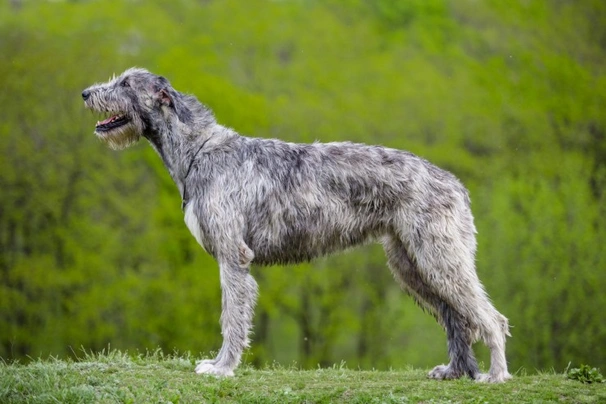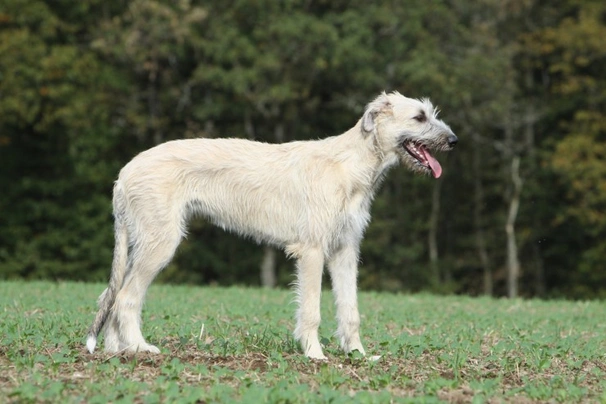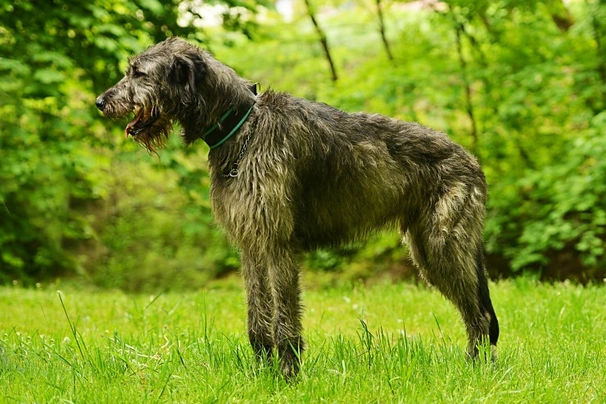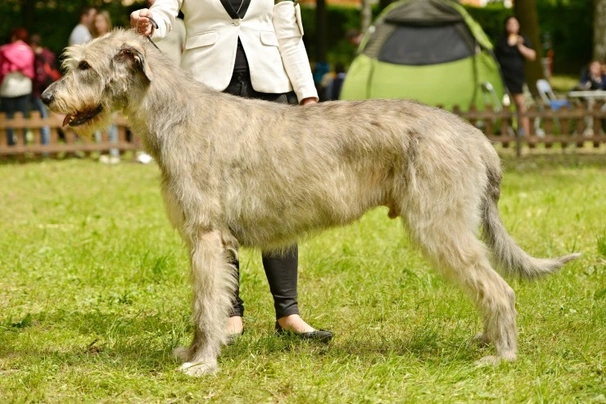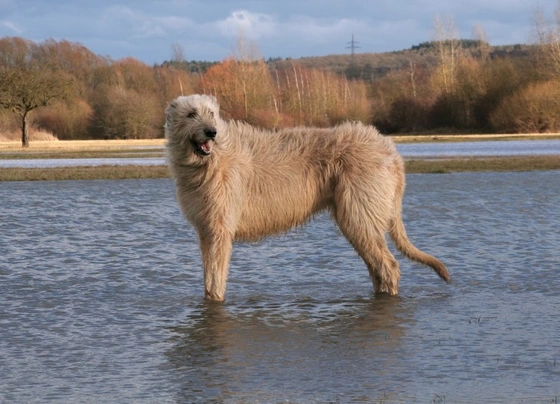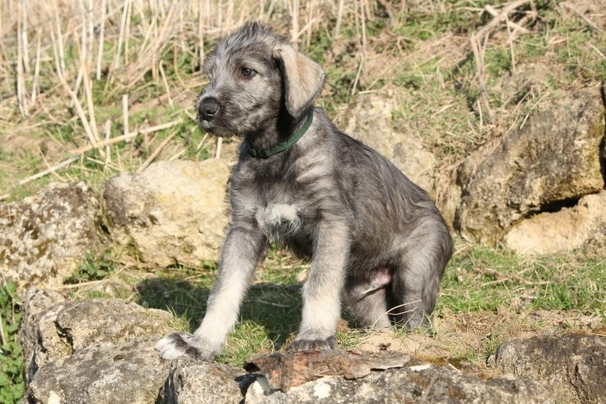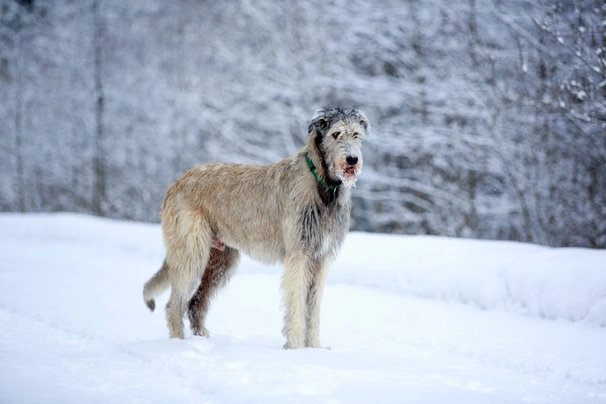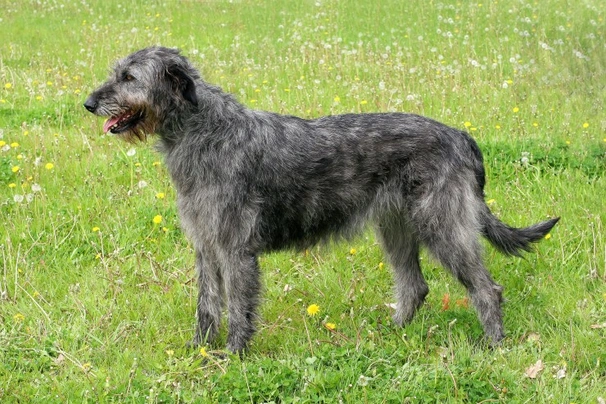Irish Wolfhound
Pros
Cons
Introduction of the Irish Wolfhound
These proud dogs are the largest of all the hound breeds and although the Irish Wolfhound boasts an impressive size they are known to be gentle giants and especially kind around children. They are renowned for their calm relaxed natures and for their turn of speed. With this said although the Irish Wolfhound is tall and large they are perfectly balanced dogs boasting a harsh rough coat that suits their overall appearance to a tee.
Anyone wanting to share a home with one of these impressive dogs might well need to accept being put on a waiting list because not many well-bred Irish Wolfhound puppies are registered with the Kennel Club every year which means they can be hard to come by. They are not the best choice for first time dog owners because they need to be socialised handled and trained by people who are familiar with the specific needs of an Irish Wolfhound.
History of the Irish Wolfhound
It is estimated that Irish Wolfhounds have been around since 7000 BC which makes them one of the most ancient breeds on the planet and the largest hound breed too. Their name in ancient times was "Cu" which translated from ancient Irish means hound war dog wolf dog and Irish Hound. There is mention of these dogs in Irish laws that existed well before Christianity there are also records of them in a lot of ancient Irish literature written back in the 5th Century.
Irish Hounds were highly prized but only Kings and nobility could own them but the number of hounds anyone could own depended on their station in life. During war times the hounds were used to drag men off their horses and to pull men out of chariots but these hounds were also used to protect herds and property too. They were highly prized hunters and would work alongside their handlers tracking down elk deer wolves and wild boar.
It was standard practice in ancient time to offer Irish Hounds as gifts to foreign nobles and other dignitaries with one dog being sent to the King of Wales in 1210 AD by John of England who was to become King. Other nobles and important people to have been given an Irish Hound included the Great Mogul the Shah of Persia Cardinal Richelieu and many hounds were offered to the King of Spain. King John of Poland took so many Irish Hounds that it nearly led to their extinction before a total ban was set in place in 1652.
By the late 1700's all the wolves had been killed in Ireland which saw a decline in the number or Irish Hounds too. People began keeping them as companions rather than hunting dogs as a result. It was at this time that a lot of outcrossing took place with Great Danes being introduced into the mix. In the middle of the 19th Century a breed enthusiast by the name of Major H. D. Richardson claimed that the Irish Wolfdog and the Highland Deerhound were the same breed of hound but he began a breeding programme with an end goal being to increase the size of his hounds back to their original stature which he did using specific and well-chosen lines. Although little is known of the Major's breeding programme it is thought that he introduced other breeds into the mix which included the Pyrenean which was a different dog to the one we know and see today being much like the Spanish hounds of times long past.
Another breed enthusiast was a man named Captain George Augustus Graham who made it his mission to improve the breed back to its former glory and although it was hard to find good examples of the Irish Wolfhound at the time he did succeed by using Glengarry Deerhounds Borzois and a Tibetan in his breeding programme. With this said the Great Dane was used in many breeding programmes right up to the 1930's as a way of saving and improving the breed.
Like many other breeds the Irish Wolfhound suffered during the First and Second World Wars when their numbers fell dangerously low but again thanks to the efforts and endeavours of many breed enthusiasts the Irish Wolfhound was saved from vanishing off the face of the planet once again with the Irish Wolfhound Club being founded in 1885. An Irish Wolfhound was to be made the Irish Guard's mascot in 1902 and the breed was subsequently recognised by the Kennel Club in 1925. In 1981 the Irish Wolfhound Society was established and over time breed numbers have increased albeit slowly. Today although the breed is known the world over the Irish Wolfhound remains an Irish national treasure and not many puppies are registered with the Kennel Club with just under 300 being recorded in 2015. As such anyone wanting to share a home with an Irish Wolfhound would need to register their interest with breeders and go on a waiting list for the pleasure of doing so.
Interesting facts about the breed
- Is the Irish Wolfhound a vulnerable breed? No although finding a well-bred puppy can be challenging
- Irish Wolfhounds are among one of the tallest breeds in the world
- Being gentle giants they are not natural watchdogs
- The breed has one of the longest recorded histories
- Irish Wolfhounds are tenacious and fearless hunters
- Although they need a lot of exercise they can be quite lazy too
- During the 19th Century the breed nearly vanished altogether
Appearance of the Irish Wolfhound
Height at the withers: Males 71 - 90 cm Females 71 - 90 cm
Average weight: Males 40 - 69 kg Females 40 - 69 kg
When Wolfhounds first appeared on the scene centuries ago there were two types with dogs boasting either a smooth coat or a rough one but the hounds we see today have coarse rough coats that match their overall appearance perfectly. Irish Wolfhounds are the largest and tallest of all hound breeds but they boast having a perfect balance and a symmetry that gives them their graceful yet muscular look.
Their head is long which dogs carry high adding to their proud and noble look. They also boast a long muzzle that's moderately pointed with dogs having black noses and lips. Their eyes are full oval-shaped and dark in colour. For such large dogs the Irish Wolfhound boasts small rose-shaped ears which boast a velvety texture to the touch. Their ears are dark and dog's carry them away from their faces.
They have strong jaws with a perfect scissor bite where their upper teeth neatly overlap their lower ones. Irish Wolfhounds have long strong and muscular necks that dogs carry well arched. Their shoulders are well-muscled with dogs having quite broad sloping chests. Their front legs are well developed strong and straight.
They are long backed and boast well arched loins with their belly being well drawn up which adds to their balance and symmetrical lines. They have well-muscled thighs and second thighs with strong long back legs. Their feet are quite large and round with well arched closed toes and their nails are curved and extremely strong. Tails are long and quite thick slightly curved and they are well covered in hair which dogs carry quite low.
When it comes to their coat the Irish Wolfhound boasts a harsh rough coat on their body head and legs but it is especially long and wiry around their eyes and under a dog's jaw. The recognised colours for Kennel Club registration are as follows:
- Black
- Black Brindle
- Brindle
- Cream
- Dark Brindle
- Fawn
- Grey
- Grey Brindle
- Red
- Red Brindle
- Wheaten
- Wheaten Brindle
Faults
The Kennel Club frowns on any exaggerations or departures from the breed standard and would judge the faults on how much they affect a dog's overall health and wellbeing as well as their ability to perform.
Males should have both testicles fully descended into their scrotums and it is worth noting that a dog can be a little lighter or heavier as well as slightly taller or shorter than set out in the Kennel Club breed standard which is only given as a guideline.
Temperament of the Irish Wolfhound
Although very large and tall the Irish Wolfhound is a truly kind friendly and gentle giant. With this said they are not the best choice for first time owners simply because being hounds these dogs need to be given the right amount of training and guidance from a young age and then throughout their lives to be truly happy well-rounded characters. As such they are better suited to people who are familiar with how to manage and handle this type of large hound.
One thing about the Wolfhound that most people notice apart from their size is the fact they never seem to rush things but when they do put on a turn of speed they can cover a tremendous amount of ground. They are not high energy dogs but they do need to be given a ton of daily exercise to keep them happy healthy and fit. They also need to be given the right amount of mental stimulation to prevent boredom from setting in which could see a dog looking for other ways to amuse and entertain themselves. In short they may well develop some unwanted behavioural issues which is best avoided if they get bored.
Irish Wolfhounds thrive on being around their owners and do not do well if they are left to their own devices even for shorter lengths of time. They are a great choice for people who work from home or where one family member usually stays at home during the day when everyone else is out of the house. They are not a good choice for people who work all day and who leave their dogs alone during this time. In a nutshell the Irish Wolfhound is a real gent and they are a delight to be around however they are not the sort of hound that can be taken on too lightly.
They can be a little wary and aloof around strangers but these hounds very rarely show any sort of aggressive behaviour towards anyone.
Are they a good choice for first time owners?
Irish Wolfhounds are not the best choice for first time dog owners because they need to be handled and trained by people who are familiar with the specific needs of such a large breed.
What about prey drive?
Irish Wolfhounds are very social by nature but being hounds they have a very high prey drive and should never be trusted around small animals pets wildlife or livestock because their strong natural instinct to chase and hunt would get the better of them.
What about playfulness?
Irish Wolfhounds have a very playful side to their natures and love to entertain and be entertained more especially when they are puppies which is when playtime can be quite boisterous. It's best to teach a puppy that play takes place outside to prevent breakages around the home.
What about adaptability?
Irish Wolfhounds are a very large breed and as such they need enough room to express themselves as they should. They are better suited to people who have ultra-secure large back gardens with high fencing that a dog can roam in whenever possible. As such they are not well suited to apartment living being much happier living in a country environment.
What about separation anxiety?
Irish Wolfhounds form extremely strong ties with their families and dogs are never very happy when they find themselves left on their own for longer periods of time. They are better suited to people who either work from home or in households where one person stays at home when everyone else is out so they are never alone for any length of time which could see a dog suffering from separation anxiety. This can lead to them being destructive around the home which is a dog's way of relieving any stress they are feeling and a way to keep themselves entertained.
What about excessive barking?
Irish Wolfhounds are not known to be "barkers" although they do have a voice all of their own and will let owners know when they are unhappy about something or when they want something.
Do Irish Wolfhounds like water?
Most Irish Wolfhound love swimming and will take to the water whenever they can more especially when the weather is hot. However if anyone who owns a dog that does not like water should never force them to go in because it would just end up scaring them. With this said care should always be taken when walking an Irish Wolfhound off the lead anywhere near more dangerous watercourses just in case a dog decides to leap in and then needs rescuing because they cannot get out of the water on their own.
Are Irish Wolfhounds good watchdogs?
Irish Wolfhounds may look impressive but they are not natural watchdogs thanks to the fact they are so kind by nature. This means they are more likely to say hello to someone rather than bark at them.
Intelligence / Trainability of the Irish Wolfhound
The Irish Wolfhound is an intelligent dog but they need to be handled correctly and their training must be started early always taking a gentle approach to things. Puppies are usually quite well-behaved and they are quiet too. However when training an Irish Wolfhound it's best to be very patient and to show a dog a lot of understanding never attempting to rush things which would just end up being a complete disaster due their sensitive natures.
Irish Wolfhound puppies are very cute and it is all too easy to spoil them when they first arrive in their new homes. However they quickly grow up to be large adult dogs so it is important for owners to start out as they mean to go on. This means that as soon as a puppy is settled ground rules and boundaries must be laid out so that a puppy understands what is expected of them and what is acceptable behaviour and what is not. By laying out ground rules it also helps establish a pecking order and who is the alpha dog in a household. As such the first commands a puppy should be taught are as follows:
- Come
- Sit
- Stay
- Heel
- Quiet
- Leave it
- Down
- Bed
Children and other
Although not the best choice for first time owners the Irish Wolfhound does make a great family pet for people who are familiar with this type of large hound and therefore know their needs. With this in mind they are known to be very good around children although it should be said that their size alone means that adult supervision is necessary whenever they are around children and more especially toddlers.
Irish Wolfhounds are usually good around other dogs but care needs to be taken when they are around any small pets and animals which includes cats because their natural instincts might just kick in.
Health of the Irish Wolfhound
The average life expectancy of an Irish Wolfhound is between 6 and 8 years when properly cared for and fed an appropriate good quality diet to suit their ages.
However like so many other pure breeds they are known to suffer from certain hereditary disorders which are worth knowing about if you are hoping to share your home with one of these large proud and gentle giants. The health issues that seem to affect Irish Wolfhounds the most include the following:
- Hyperekplexia - DNA test available
- Hip dysplasia - dogs should be hip scored with the mean score for the breed being 6
- Elbow dysplasia - dogs must be tested with the mean score being 0
- Dilated cardiomyopathy
- Osteosarcoma (bone cancer)
- Leptospirosis
- Epilepsy
- Rhinitis - bacterial infection that affects the lungs
- Wobbler syndrome
- Von Willebrand's disease
- Entropion(Eyelids Folding Inwards )
- Panosteitis
- Cataracts
- Autoimmune disease
- Gastric torsion/bloat
Irish Wolfhounds are also known to suffer from growth issues. As such the feeding and exercise requirements of young and older dogs need to be carefully monitored and controlled but more especially in puppies. It is also essential that nursing bitches be constantly watched over for the first three weeks after they have given birth to puppies because mothers can accidentally crush them.
What about vaccinations?
Irish Wolfhound puppies would have been given their initial vaccinations before being sold but it is up to their new owners to make sure they have their follow-up shots in a timely manner with the vaccination schedule for puppies being as follows:
- 10 -12 weeks old bearing in mind that a puppy would not have full protection straight away but would be fully protected 2 weeks after they have had their second vaccination
There has been a lot of discussion about the need for dogs to have boosters. As such it's best to talk to a vet before making a final decision on whether a dog should continue to have annual vaccinations which are known as boosters.
What about spaying and neutering?
A lot of vets these days recommend waiting until dogs are slightly older before spaying and neutering them which means they are more mature before undergoing the procedures. As such they advise neutering males and spaying females when they are between the ages of 6 to 9 months old and sometimes even when a dog is 12 months old.
Other vets recommend spaying and neutering dogs when they are 6 months old but never any earlier unless for medical reasons. With this said many breeds are different and it is always advisable to discuss things with a vet and then follow their advice on when a dog should be spayed or neutered.
What about obesity problems?
Irish Wolfhounds can gain weight after they have been spayed or neutered and it's important to keep an eye on a dog's waistline just in case they do. If a dog starts to put on weight it's important to adjust their daily calorie intake and to up the amount of exercise they are given. Older dogs too are more prone to gaining weight and again it's essential they be fed and exercised accordingly because obesity can shorten a dog's life by several years. The reason being that it puts a lot of extra strain on a dog's internal organs including the heart which could prove fatal more especially as they are known to suffer from heart issues anyway.
What about allergies?
Some Irish Wolfhounds are prone to suffering from allergies and it's important for a dog to see a vet sooner rather than later if one flares up. Allergies can be notoriously hard to clear up and finding the triggers can be challenging. With this said a vet would be able to make a dog with an allergy more comfortable while they try to find out the triggers which could include the following:
- Certain dog foods that contain high levels of grains and other cereal-type fillers
- Airborne pollens
- Dust mites
- Environment
- Flea and tick bites
- Chemicals found in everyday household cleaning products
Participating in health schemes
All responsible Irish Wolfhound breeders would ensure that their stud dogs are tested for known hereditary and congenital health issues known to affect the breed by using the following schemes:
- Hip scored - the mean score for Irish Wolfhounds is 6
- Elbow tested - the ideal score for the breed is 0
- Eye tested for multifocal retinal dysplasia
- Eye tested for progressive retinal atrophy
- DNA tested for hyperekplexia
- Annual heart test
- Puppies must be tested for portosystemic liver shunt
- Bitches under the age of 2 years should not produce a litter
- Bitches over the age of 6 years should not to produce a litter
- Bitches should not produce more than 1 litter in any 12-month period
What about breed specific breeding restrictions?
Apart from the standard breeding restrictions for all Kennel Club registered breeds there are no other breed specific breeding restrictions for the Irish Wolfhound.
What about Assured Breeder Requirements?
The Kennel Club strongly recommends that all breeders both Assured and other should use the following tests on their dogs and puppies:
- Eye testing
- Bitches under the age of 2 years should not produce a litter
- Bitches over the age of 6 years should not to produce a litter
- Bitches should not produce more than 1 litter in any 12-month period
- All breeding dogs must be heart tested every year
- Puppies must be tested for liver shunt through the breed club before being sold
More about genetic diversity
When it comes to genetic diversity the Irish Wolfhound's is a little below the optimum for pure breeds standing at 5.3%. As such not too much inbreeding goes on which is good news for the breed's future and its genetic diversity.
Caring for the Irish Wolfhound
As with any other breed these large dogs need to be groomed on a regular basis to make sure their coats and skin are kept in tip-top condition. They also need to be given regular daily exercise to ensure they remain fit and healthy. On top of this they need to be fed good quality food that meets all their nutritional needs throughout their lives.
Caring for an Irish Wolfhound puppy
Irish Wolfhound puppies are boisterous and full of life which means it's essential for homes and gardens to be puppy-proofed well in advance of their arrival. A responsible breeder would have well socialised their puppies which always leads to more outgoing confident and friendly dogs right from the word go. With this said any puppy is going to feel vulnerable when they leave their mother and littermates which must be taken into account. The longer a puppy can remain with their mother the better although it should never be for too long either.
It's best to pick a puppy up when people are going to be around for the first week or so which is the time needed for a puppy to settle in. Puppy-proofing the home and garden means putting away any tools and other implements that a boisterous puppy might injure themselves on. Electric wires and cables must be put out of their reach because puppies love chewing on things. Toxic plants should be removed from flowerbeds and the home too.
Puppies need to sleep a lot to grow and develop as they should which means setting up a quiet area that's not too out of the way means they can retreat to it when they want to nap and it's important not to disturb them when they are sleeping. It's also a good idea to keep "playtime" nice and calm inside the house and to have a more active "playtime" outside in the garden which means puppies quickly learn to be less boisterous when they are inside.
The documentation a breeder provides for a puppy must have all the details of their worming date and the product used as well as the information relating to their microchip. It is essential for puppies to be wormed again keeping to a schedule which is as follows:
- Puppies should be wormed at 6 months old
- They need to be wormed again when they are 8 months old
- Puppies should be wormed when they are 10 months old
- They need to be wormed when they are 12 months old
Things you'll need for your puppy
There are certain items that new owners need to already have in the home prior to bringing a new puppy home. It's often a good idea to restrict how much space a puppy plays in more especially when you can't keep an eye on what they get up to bearing in mind that puppies are often quite boisterous which means investing in puppy gates or a large enough playpen that allows a puppy the room to express themselves while keeping them safe too. The items needed are therefore as follows:
- Good quality puppy or baby gates to fit on doors
- A good well-made playpen that's large enough for a puppy to play in so they can really express themselves as puppies like to do
- Lots of well-made toys which must include good quality chews suitable for puppies to gnaw on bearing in mind that a puppy will start teething anything from when they are 3 to 8 months old
- Good quality feed and water bowls which ideally should be ceramic rather than plastic or metal
- A grooming glove
- A slicker brush or soft bristle brush
- Dog specific toothpaste and a toothbrush
- Scissors with rounded ends
- Nail clippers
- Puppy shampoo and conditioner which must be specifically formulated for use on dogs
- A well-made dog collar or harness
- A couple of strong dog leads
- A well-made dog bed that's not too small or too big
- A well-made dog crate for use in the car and in the home that's large enough for a puppy to move around in
- Baby blankets to put in your puppy's crate and in their beds for when they want to nap or go to sleep at night
Keeping the noise down
All puppies are sensitive to noise including Irish Wolfhound puppies bearing that like all hounds they are ultra-sensitive to loud sounds by nature and this even includes raised voices. It's important to keep the noise levels down when a new puppy arrives in the home. TVs and music should not be played too loud which could end up stressing a small puppy out.
Keeping vet appointments
As previously mentioned Irish Wolfhound puppies would have been given their first vaccinations by the breeders but they must have their follow up shots which is up to their new owners to organise. The vaccination schedule for puppies is as follows:
- 10 -12 weeks old bearing in mind that a puppy would not have full protection straight away but would only be fully protected 2 weeks after they have had their second vaccination
When it comes to boosters it's best to discuss these with a vet because there is a lot of debate about whether a dog really needs them after a certain time. However if a dog ever needed to go into kennels their vaccinations would need to be fully up to date.
What about older Irish Wolfhounds when they reach their senior years?
Older Irish Wolfhounds need lots of special care because as they reach their golden years they are more at risk of developing certain health concerns. Physically a dog's muzzle may start to go grey but there will be other noticeable changes too which includes the following:
- Coats become coarser
- A loss of muscle tone
- Irish Wolfhounds can either become overweight or underweight
- They have reduced strength and stamina
- Older dogs have difficulty regulating their body temperature
- They often develop arthritis
- Immune systems do not work as efficiently as they once did which means dogs are more susceptible to infections
Older dogs change mentally too which means their response time tends to be slower as such they develop the following:
- They respond less to external stimuli due to impaired vision or hearing
- They tend to be a little pickier about their food
- They have a lower pain threshold
- Become intolerant of any change
- Often an older dog can feel disorientated
Living with an Irish Wolfhound in their golden years means taking on a few more responsibilities but these are easily managed and should include taking a look at their diet the amount of exercise they are given how often their dog beds need changing and keeping an eye on the condition of their teeth.
Older Irish Wolfhounds must be fed a good quality diet that meets their needs at this stage of their lives all the while keeping a close eye on a dog's weight. A rough feeding guide for older dogs is as follows bearing in mind they should be fed highly digestible food that does not contain any additives:
- Protein content should be anything from 14 – 21%
- Fat content should be less than 10%
- Fibre content should be less than 4%
- Calcium content should be 0.5 – 0.8%
- Phosphorous content should be 0.4 – 0.7%
- Sodium content should be 0.2 – 0.4%
Older Irish Wolfhounds don't need to be given the same amount of daily exercise as a younger dog but they still need the right amount of physical activity to maintain muscle tone and to prevent a dog from putting on too much weight. All dogs need access to fresh clean water and this is especially true of older dogs when they reach their golden years because they are more at risk of developing kidney disorders.
Grooming of the Irish Wolfhound
An Irish Wolfhound's coat is wiry and rough which means a weekly brush is essential to keep their skin and coats in good condition. It's also important for these dogs to be hand stripped at least twice a year and more especially when they shed most which is during the Spring and then again in the Autumn.
It's also essential for a dog's ears to be checked on a regular basis to ensure no infections are flaring up because once they do they can be notoriously difficult to clear up once an infection takes hold.
Exercise of the Irish Wolfhound
Although Irish Wolfhounds never do much in a hurry they are however athletic dogs which means they need a minimum of 2 hour’s daily exercise to keep them fit both physically and mentally. When it comes to Irish Wolfhound puppies they only need to be given a little amount of exercise because their bones and joints are still growing and developing. If too much pressure is put on them it could lead to some serious joint and bone issues later in a dog's life. With this said a good 15 minute’s romp in the garden would be enough for puppies but their playtime should always be supervised.
Older dogs like to be able to roam around a large back garden whenever they can but the fencing needs to be very secure and high although they are not known to jump fences but if they find way out they are liable to go wandering off. When walking an Irish Wolfhound anywhere near farm stock they must be kept on the lead because otherwise their strong instinct to chase will take over with disastrous results.
Feeding of the Irish Wolfhound
If you get an Irish Wolfhound puppy from a breeder they would give you a feeding schedule and it's important to stick to the same routine feeding the same puppy food to avoid any tummy upsets. You can change a puppy's diet but this needs to be done very gradually always making sure they don't develop any digestive upsets and if they do it's best to put them back on their original diet and to discuss things with the vet before attempting to change it again. With this said it is vital that a puppy's diet be carefully monitored because Irish Wolfhounds grow very fast when they are young.
Older dogs are not known to be fussy or finicky eaters but this does not mean you can feed them a lower quality diet. Their diet must contain all the right vitamins minerals and other nutrients these large dogs need to stay healthy. It's also important that dogs be given the right amount of exercise so they burn off any excess calories or they might gain too much weight which can lead to all sorts of health issues. Obesity can shorten a dog's life by several years so it's important to keep an eye on their waistline from the word go.
Because Irish Wolfhounds are prone to suffer from bloat it is really important that they be fed twice a day instead of giving them just one larger meal a day. It's also a good idea to invest in a stand to place their feed bowl which makes it easier for these large dogs to eat comfortably without having to stretch their necks down low to reach their food. You should never feed an Irish Wolfhound just before or just after they have eaten either because this puts them more a risk of suffering from bloat.
Feeding guide for an Irish Wolfhound puppy
Puppies need to be fed a highly nutritious good quality diet for them to develop and grow as they should. As a rough guide an Irish Wolfhound puppy can be fed the following amounts every day making sure their meals are evenly spread out throughout the day and it's best to feed them 3 or 4 times a day:
- 2 months old - 289g to 409g depending on puppy's build
- 3 months old - 386g to 560g depending on puppy's build
- 4 months old - 429g to 627g depending on puppy's build
- 5 months old - 514g to 751g depending on puppy's build
- 6 months old - 587g to 859g depending on puppy's build
- 7 months old - 589g to 872g depending on puppy's build
- 8 months old - 585g to 874g depending on puppy's build
- 9 months old - 537g to 858g depending on puppy's build
- 10 months old - 501g to 808g depending on puppy's build
- 11 months old - 456g to 754g depending on puppy's build
- 12 months old - 414g to 701g depending on puppy's build
- 13 months old - 411g to 657g depending on puppy's build
- 14 months old - 406g to 616g depending on puppy's build
Once a puppy is 24 months old they can be fed adult dog food.
Feeding guide for an adult Irish Wolfhound
Once fully mature an adult Irish Wolfhound must be fed a good quality diet to ensure their continued good health. As a rough guide an adult Irish Wolfhound can be fed the following amounts every day:
- Dogs weighing 40 kg can be fed 384g to 509g depending on activity
- Dogs weighing 50 kg can be fed 428g to 593g depending on activity
- Dogs weighing 60 kg can be fed 499g to 663g depending on activity
- Dogs weighing 69 kg can be fed 538g to 731g depending on activity
Irish Wolfhound price
If you are looking to buy an Irish Wolfhound you may have to go on a waiting list because not many puppies are offered for sale every year. You would need to pay anything from £750 to over £1000 for a well-bred pedigree puppy. The cost of insuring a male 3-year-old Irish Wolfhound in northern England would be £74.56 a month for basic cover but for a lifetime policy this would set you back £134.21 a month (quote as of January 2018). When insurance companies calculate a pet's premium they factor in several things which includes where you live in the UK and a dog's age and whether they have been neutered or spayed.
When it comes to food costs you need to buy the best quality food whether wet or dry to feed your dog throughout their lives making sure it suits the different stages of their lives. This would set you back between £60 - £80 a month. On top of this you would need to factor in veterinary costs if you want to share your home with an Irish Wolfhound and this includes their initial vaccinations their annual boosters the cost of neutering or spaying your dog when the time is right and then their yearly health checks all of which quickly adds up to over a £1400 a year.
As a rough guide the average cost to keep and care for one of these large dogs would be between £130 to £200 a month depending on the level of insurance cover you opt to buy for your dog but this does not include the initial cost of buying a healthy well-bred Kennel Club registered pedigree Irish Wolfhound puppy.
Buying advice
If you are looking to purchase an Irish Wolfhound, you may need to get on a waiting list as there aren't many puppies available for sale each year. You should expect to pay between £750 and over £1000 for a well-bred pedigree puppy. The cost to insure a 3-year-old male in North England would be £74.56 per month for basic coverage, but for a lifetime policy, it would cost you £134.21 per month (quote from January 2018). When insurance companies calculate the premium for a pet, they consider various factors including where you live in the UK, the dog's age, and whether it has been neutered or spayed.
As for food costs, you need to purchase high-quality food, both wet and dry, to feed your dog throughout its life, ensuring that it is appropriate for the different stages of its life. This will cost you between £60 and £80 per month. You should also add veterinary costs if you wish to share your home with an Irish Wolfhound, including initial vaccinations, annual boosters, the cost of neutering or spaying the dog when the time is right, and annual health check-ups, all of which quickly add up to over £1400 per year.
As a rough guide, the average cost to maintain and care for one of these large dogs would be between £130 and £200 per month, depending on the level of insurance coverage you choose for your dog, but this does not include the initial cost of purchasing a healthy, well-bred Irish Wolfhound puppy registered with the Kennel Club.

